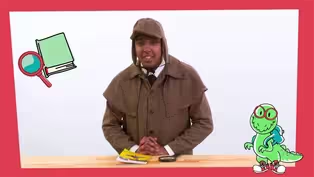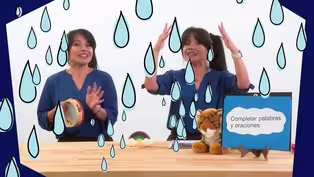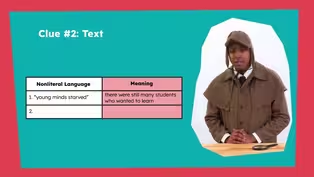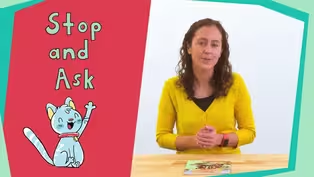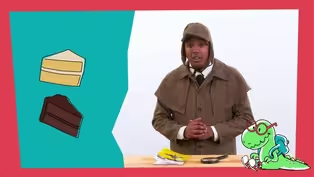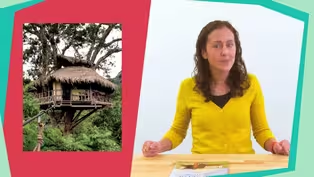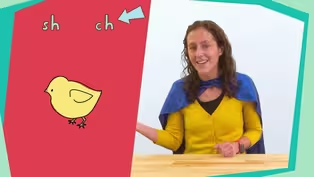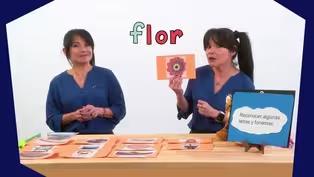
Episode 24 | Literacy Lessons
4/6/2021 | 28m 46sVideo has Closed Captions
Literacy lessons for early learners, led by NC teachers.
The first lesson (aimed at 3rd graders) helps students identify main ideas and their supporting details within the text. The second lesson (aimed at 1st-2nd graders) helps learners understand that letters make sounds and those sounds work together to make words. Classroom Connection is your At-Home Learning companion where children love to learn. All lessons are led by NC educators.
Problems playing video? | Closed Captioning Feedback
Problems playing video? | Closed Captioning Feedback
At-Home Learning Presents: Classroom Connection is a local public television program presented by PBS NC

Episode 24 | Literacy Lessons
4/6/2021 | 28m 46sVideo has Closed Captions
The first lesson (aimed at 3rd graders) helps students identify main ideas and their supporting details within the text. The second lesson (aimed at 1st-2nd graders) helps learners understand that letters make sounds and those sounds work together to make words. Classroom Connection is your At-Home Learning companion where children love to learn. All lessons are led by NC educators.
Problems playing video? | Closed Captioning Feedback
How to Watch At-Home Learning Presents: Classroom Connection
At-Home Learning Presents: Classroom Connection is available to stream on pbs.org and the free PBS App, available on iPhone, Apple TV, Android TV, Android smartphones, Amazon Fire TV, Amazon Fire Tablet, Roku, Samsung Smart TV, and Vizio.
Providing Support for PBS.org
Learn Moreabout PBS online sponsorshipMore from This Collection
Video has Closed Captions
Literacy lessons for early learners, led by NC teachers. (28m 46s)
Video has Closed Captions
Literacy lessons for early learners, led by NC teachers. (28m 46s)
Video has Closed Captions
Literacy lessons for early learners, led by NC teachers. (28m 45s)
Video has Closed Captions
Literacy lessons for early learners, led by NC teachers. (28m 45s)
Video has Closed Captions
Literacy lessons for early learners, led by NC teachers. (28m 46s)
Video has Closed Captions
Literacy lessons for early learners, led by NC teachers. (28m 46s)
Video has Closed Captions
Literacy lessons for early learners, led by NC teachers. (28m 45s)
Video has Closed Captions
Short Description: Literacy lessons for early learners, led by NC teachers. (28m 45s)
Video has Closed Captions
Literacy lessons for early learners, led by NC teachers. (28m 45s)
Video has Closed Captions
Literacy lessons for early learners, led by NC teachers. (28m 45s)
Video has Closed Captions
Literacy lessons for early learners, led by NC teachers. (28m 45s)
Video has Closed Captions
Literacy lessons for early learners, led by NC teachers. (28m 45s)
Providing Support for PBS.org
Learn Moreabout PBS online sponsorship[cheerful upbeat music] ♪ - Do you ever feel like a superhero when you learn something new?
Maybe it's just me then but I feel like I could do anything when I learn new things.
It's so great to be able to learn with you today.
- Hi everyone, I'm Ms. Shannon.
Sun and I are back together to explore "Sun!
One in a Billion" one last time with you.
We've learned so much from this book.
The final thing we'll focus on with it today is determining the main idea and supporting details.
The main idea is the most important thing the author wants the reader to remember and what the text is mostly about.
The author also includes details to prove or support the main ideas in the text.
Details are like evidence that prove the main idea is true.
Watch me show you how to find the main idea and supporting details on one page of the text, and then later we'll think through the main idea and supporting details together for the whole book.
I'm going to use this tree map to organize the main idea and supporting details.
The main idea will go at the top and the supporting details will go underneath it to prove that it's true.
I'm going to read some pages and think about what the main idea could be, read with me.
But you can't fill me with Earths because I'm hot stuff.
Compare a hot summer day 90 degrees Fahrenheit, a pizza oven 700 degrees Fahrenheit, the orange yellow flames in a campfire about 2000 degrees Fahrenheit, me about 10,000 degrees Fahrenheit on the surface, I can melt diamonds, me at my center 27 million degrees Fahrenheit.
So what's the main idea or most important thing this part is mostly about?
Listen to me think it through.
I'm noticing that most of the words and pictures are about heat and temperature.
So I know it has something to do with that.
The words say I'm hot stuff and I can see from the thermometers and temperature numbers that the sun is much hotter than the other things on the page.
So the main idea seems to be that the sun is incredibly hot.
Yes, that's my main idea statement, the sun is very hot.
I'm gonna put it at the top of my tree map.
So, now I need to find some text evidence on these pages to prove or support it.
Once we find those, we'll add them here under the main idea.
Hmm, what do I see in the words that shows that the sun is extremely hot?
Let's go through each part.
You can't fill me with Earths, does that show that the sun is hot?
No, that's about size so that's not a supporting detail for this main idea, which is about temperature.
Next it shows us that a hot summer day, a pizza oven and a campfire are all cooler than the sun.
It says it in the words, and it shows us in the pictures with the little thermometers.
Is that evidence that the sun is hot?
Yes, so that is a supporting detail for our main idea, I'll add that to our tree map.
Next, the text says that the sun is 10,000 degrees Fahrenheit on the surface and 27 million degrees Fahrenheit at its center.
Does that support our main idea that the sun is extremely hot?
Yes, I'll add it to our graphic organizer.
So far, we have two supporting details that show our main idea is accurate.
Let's see if we can find one more.
The text says here that the sun can melt diamonds.
Does that prove it's extremely hot?
Absolutely, you would need something really hot to melt diamonds, I'll add this to our graphic organizer also.
Awesome, now we have a main idea, the sun is extremely hot with three supporting details.
All of the supporting details help to prove the main idea that the sun is extremely hot.
A summer day, pizza oven and fire are all cooler than the sun, the sun is 10,000 degrees Fahrenheit on the surface and 27 million degrees Fahrenheit at its center.
The sun can melt diamonds.
This tree map keeps our thinking organized and helps me see how these details support the main idea.
Now it's your turn to help me.
I just showed you how to find the main idea and supporting details for a smaller portion of the text.
So now let's work together to identify the main idea of the entire text and some supporting details that prove it.
We'll use another tree map for this part.
Sometimes titles of texts can give you a sense of what the overall main idea is, so let's start there.
The title is "Sun!
One in a Billion."
When you hear people use the expression one in a million, they mean that something is very special.
So, if I said that this marker was one in a million because it writes so well, that would mean it's really unique and wonderful.
Hey, stop trying to steal that marker Sun.
The title of this book is a play on that expression.
A billion is more than a million so the title is insisting that the Sun is super special because it's one in a whole billion instead of just a million.
Now, let's think about if we heard more about that idea that the Sun is really important throughout the book.
Here are some things the Sun said about itself in the text.
That magnificent and important star was me, I am the most important, you're welcome.
I'm so important, I'm famous, the planets are attracted to me, life revolves around me.
I'm a big, big deal, I'm hot stuff, I'm generous and good-looking, and it makes us spell its name with a capital S because it's so important.
When you think about the title along with what the pages in the book say about how special the Sun is, what do you think the main idea or what the author wants us to remember the most could be?
Great thinking, I think the main idea is that the sun is extremely important.
That's why it's repeated so much throughout the book.
Let's add that to our tree map.
Now, let's go through the book and find supporting details that show or prove that this main idea is true.
Let's start with this page, read it with me and look for supporting details as we go.
Can you hang out for eight minutes?
That's how long it takes my light to reach Earth.
Yep, I give you heat and light, you are welcome.
I'm so important that Earthlings should name a special day in my honor, we can call it Sunday.
Oh wait, what supporting details do you see here that prove our main idea that the sun is really important?
I see this one that says the sun gives us heat and light.
And I also see that there's a special day named in the sun's honor.
Both of those details support our main idea that the sun is really important because both of them show how and why the sun matters so much.
Let's add them to our tree map.
Let's try another.
What do you see on these pages?
Read with me.
I'm famous for my heat and light but I also hold our entire solar system together.
Scientists call it gravity.
What can I say?
The planets are attracted to me.
What new detail is here that supports our main idea that the sun is really important?
Great thinking, the sun holds our entire solar system together with gravity, that really is important.
Another supporting detail to add to our tree map.
This page also says that the sun gives heat and light but we already have that on our tree map so we don't need to add it again.
Authors often repeat things that are really important.
So it's nice to see the details about heat and light here again because it confirms that our thinking is on the right track.
Let's read the author's note at the end and see if we can find any other supporting details for our main idea, that the sun is really important.
You can read with me.
Dear reader, I love our Sun and I think he deserves a name.
Perhaps Buck or Reginald or Mostes Importenus Centauri.
Earth our very own Planet Awesome would not exist without Sun and without Earth, there would be no chocolate chip cookies, picture books or frisky puppies which are a few of my favorite things.
So I guess I need to say thank you Sun with a capital S. Thank you for light, heat, energy and the gravity that keeps Earth revolving at the most perfect distance from your super hot surface.
Too close, we'd be scorched, too far away we'd freeze.
You're one in a billion, with gratitude Stacy McAnulty, Author and frequent wearer of sunblock.
I'm noticing that this sentence lists lots of supporting details for why the sun is important.
Do you see one there that we haven't already added to our tree map?
Yes, I'm noticing that we already have light, heat and gravity in our tree map, but we don't have energy.
That seems like a supporting detail that we should add to prove the sun is really important.
On page six, we saw Earthlings holding plants and plants need the sun's energy to grow.
Without the sun's energy we would starve, let's add that to our tree map.
Awesome job everyone.
Today we learned that the main idea is the most important thing the author wants the reader to remember, and what the text is mostly about.
The author also includes details to prove or support the main ideas in the text.
Details are like evidence that prove the main idea is true.
We found the main idea of one page and the details that supported it then we found the main idea of the entire book and supporting details for that.
We used a graphic organizer called a tree map to organize our ideas.
Remember when you're reading informational texts on your own to try to find the main ideas and supporting details.
That way, you'll know what the author wants you to remember most.
I'll see you next time when we explore some poetry about the sun, bye.
- Maybe you didn't know this about me but I love to cook.
It feels so good to combine and prepare ingredients with love and watch others enjoy what you've made.
We have a great cooking video for you to watch and maybe you can try this at home.
- My recipe is Korean lentil patties with a dollop of Greek yogurt with dill.
First, what we did is make the lentils and we put vegetable broth and lentils in one pan and let it simmer and boil and then we let them cool and mixed all the other ingredients together.
When we mix them all together, we dip them in panko and let them refrigerate for 30 minutes.
And then after they're done refrigerating, we put them in the oven for 25 minutes.
When you're done, you pull them out of the oven and if you want you can put the dill sauce on top and then you're ready to eat them.
Cooking is very good for you and it's a very good hobby to have and you could especially get healthier and know what goes into your dish.
- Did you know the country Scotland has 421 words for the word snow?
For instance [in foreign language] means to swirl, what?
Also the unicorn is the national animal of Scotland, this is exploding my brain.
Let's practice some reading so I can learn more awesome facts of about Scotland.
[lively instrumental music] - Hello readers, my name is Ms.Gary and I'm so excited to be learning with you today.
Before we get started with our lesson, let's say hello with our welcome song.
♪ Hello readers hello readers ♪ ♪ How are you how are you ♪ ♪ I'm so glad to see you I'm so glad to teach you ♪ ♪ Hello you you and you ♪ Well readers, have you ever wondered how we know what sounds to say when we are reading words?
When I'm reading words or hearing words, how do I know what sounds the letters make or what sounds are in the words?
How do I know what letters are used to make those sounds?
We know what words are and what sounds letters make because as a reader our brains are using our knowledge of letter sounds to determine what sounds we hear in words.
This is what helps us read and write words.
For example, when I read the word bat, my brain tells me the word sounds like this, B-A-T because the word bat is spelled B-A-T.
So before we can read words, we have to know what the sounds say.
So lets see and say the letter names and sounds of the letters on these cards together.
This is the letter b, the letter b makes the sound b.
Can you say b?
Good readers.
Look at this letter, this is the letter f. The letter f makes the sound f. Can you say f?
Great job readers.
Do you know what this letter is?
That's right, this is the letter g. This makes the g sound and sometimes it can make the sound g also.
This is the letter l, the letter l makes the sound l. Can you say l?
Great job.
Let's look at this letter.
This is the letter o, this is a vowel and it can say the sound o or oh, can you say that?
Here's our next letter.
This is the letter u, this is a vowel that says the sound a or u.
Here's our next letter.
This is the letter p, this makes the sound p. Can you say p like the letter p?
Great job.
And our last letter is the letter x.
The letter x makes the sound x.
Can you say x like the letter x?
Awesome work readers.
To keep practicing these letter sounds you can make letter cards too.
Just ask your responsible adult to help you gather some index cards and write the letters and then practice saying the letter names and sounds with you.
You can also practice on your own too, and this will help you get even better at knowing the letter sounds when you hear or read them.
In addition to knowing our letter sounds, during each lesson we're going to learn some words.
These words have a special name called heart words.
We call these words heart words because we'll practice reading them so that we'll know them by heart or so that we won't have to sound them out.
So let's look at this word.
This is the word what, can you say what?
Good, now let's spell it, W-H-A-T. Say it one more time, what?
Now let's put this heart word in our minds and keep it there for when we see it in a book or write it on our paper.
Here comes our next one, look at this word.
This is the word said, can you say said?
Now let's spell it, S-A-I-D. Said, let's say it one more time.
Good, now let's put this heart word in our mind and keep it there so when we see it in a book or write it on paper.
So we've practiced two heart words readers, so we have one more to go today.
Let's look at it this word.
This is the word the, can you say the?
Good, the is spelled T-H-E. Now let's put this heart word in our mind also and keep it there for when we see it in a book or write it on paper.
Great heart word practicing readers.
Now let's move on to our focus for today.
In today's lesson we're going to learn how to identify sounds we hear and the beginning, middle and ends of words.
We're also going to break those sounds apart, and then blend them back together to read the word that we hear.
So let's get started.
I'm going to show you a picture and you're going to tell me what it is.
What do you see?
That's right, it's a bug.
What letter sounds do you hear in the word bug?
Can you tell me the first or beginning sound in the word bug?
Yes, it's b.
Can you say b like in the beginning?
Now what sound do you hear in the middle of bug?
U, I hear a u.
Say the u sound in the word bug.
Now, can you tell me the last or final sound you hear in the word bug?
Right readers, I heard the g make the g sound, in the word bug.
So let's say this word, bug.
Let's say the sounds we hear, you ready?
B-U-G bug, let's say it one more time.
Bug, that's the word bug.
I'm gonna take down the word bug and show you our next picture.
Look at this picture, what do you see?
Yes readers, this is a plug.
Let's see what sounds we hear in the word plug.
The first sound we hear in the word plug is p. That's right, it's the letter p and it makes the sound p. Can you say p?
Good, what about the next sound in the word plug?
Yes, it's the l sound.
Good job.
What about the sound after?
Right, it's the u and it makes the sound u.
Can you say u?
And what's the last sound you hear in the word plug?
Great job, it's the letter g and it makes the g sound.
So now let's blend those individual sounds together, are you ready?
P-L-U-G plug, can you say it one more time?
Plug, this is the word plug.
Now I'm gonna show you another picture.
What do you see in this picture readers?
Good, this is a fox.
What's the beginning sound in the word fox?
Right, it's the f sound.
Can you say f like in fox?
Good, that's the sound the letter f makes in fox.
What about our next sound?
Yeah, I heard you say o, the letter o makes the o sound.
What about our final sound in the word fox?
Right, our x makes the x sound.
Can you make the x sound like the letter x?
Great job, so now let's blend all of our sounds together and read our whole word fox.
F-O-X, fox.
Great job.
Those sounds work together in this word to make the word fox.
Okay readers let's get ready.
Now that we've practiced identifying letter sounds and blending them back together into words, I wanna teach you a strategy for practicing this skill on your own with new words.
So let's use our word fox.
I can tap the sounds I hear in the word fox by using my fingers.
F-O-X and blend them together, fox.
Can you try it on your own?
F-O-X, fox.
Great job.
So now we're gonna practice on our own.
What picture do you see here readers?
Can you tap out the sounds that you hear in the word box?
Great, I heard you tap out the sounds word box like this.
B-O-X great job, you tapped out the sounds the word box.
B-O-X, box.
Now look at this picture, can you tell me what this is?
It's a dog but it's a special kind of dog, this is a pug Can you tap out the sounds you hear in the word pug?
Let's hear, great job.
Did you tap out P-U-G, pug?
Good, you tapped out the sounds in the word pug.
Well readers, that's the end of our lesson for today.
Thank you all for joining me as we learned about how to identify the sounds we hear in the words and blend those sounds together to read the word.
Remember to practice this skill when you're reading or writing your words, I'll see you next time readers [cat meowing].
- Well my friends it's story time, one of my favorite times of the day.
Stories have the power to move us and even change the way we think.
We get to imagine what it's like in someone else's shoes.
I wonder what we'll feel today.
[cock crowing] - Hi, my name is Hanna and I'm gonna read "All in a Day."
A day is a perfect piece of time to live a life, to plant a seed, to watch the sun go by.
A day starts early, work to do beneath a brand new sky.
[cock crowing] A day brings hope [kids laughing] and kindness too.
A day is all on its own.
You can make a wish and start again [kids laughing].
You can find your way back home [snoring].
Every bird and every tree and every living thing loves the promise in a day and love what it can bring.
[bird chirping] There's faith in the morning time, there's belief in noon.
Evening will come whispering and shine a bright round moon.
A day can change just everything given half a chance.
Rain could show up at your door and teach you how to dance.
The past is sailing off to sea, the future's fast asleep.
[bell ringing] A day is all you have to be and it's all you get to keep.
[birds chirping] Underneath that great big sky the Earth is all a spin.
This day will soon be over and it won't come back again.
So live it well, make it count, fill it up with you.
The day's all yours, it's waiting now, see what you can do.
- For more information about this programming or at home learning initiative and partner resources, please visit our website at pbsnc.org/AHL.
[cheerful upbeat music] ♪
Support for PBS provided by:
At-Home Learning Presents: Classroom Connection is a local public television program presented by PBS NC
